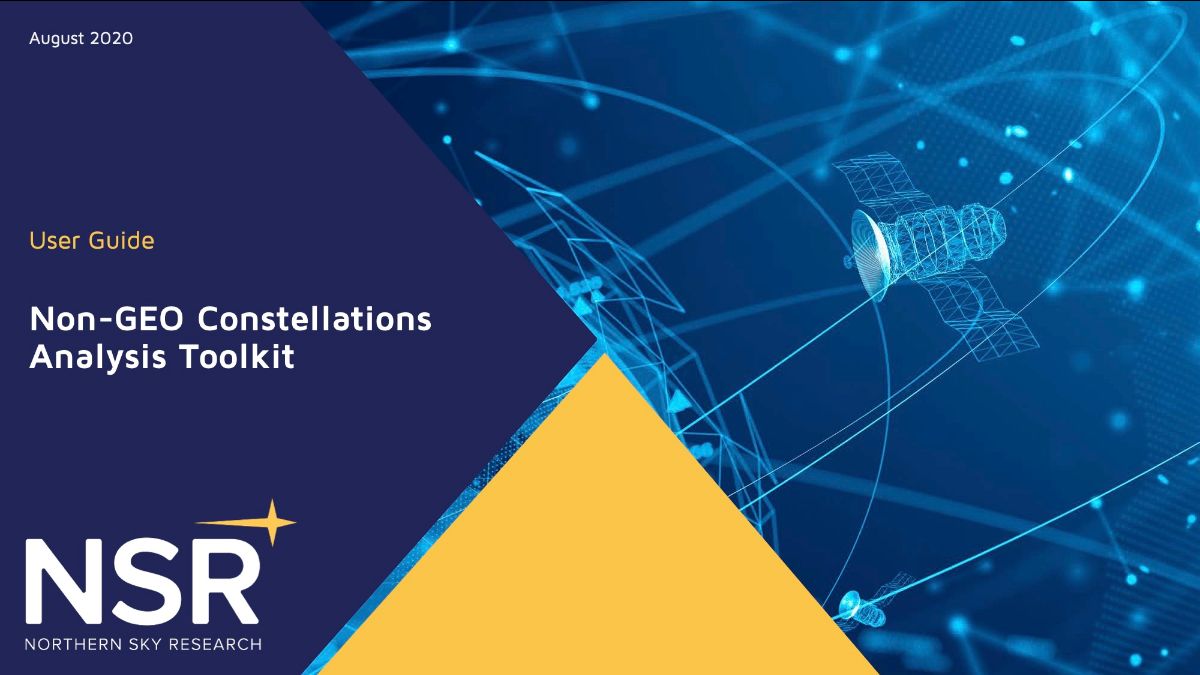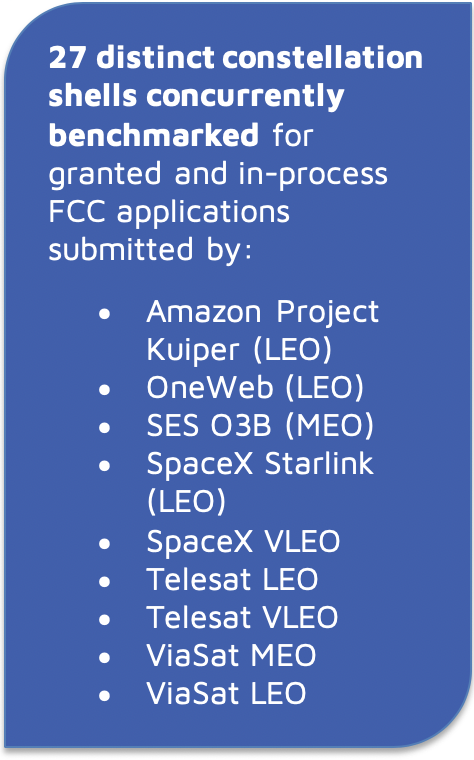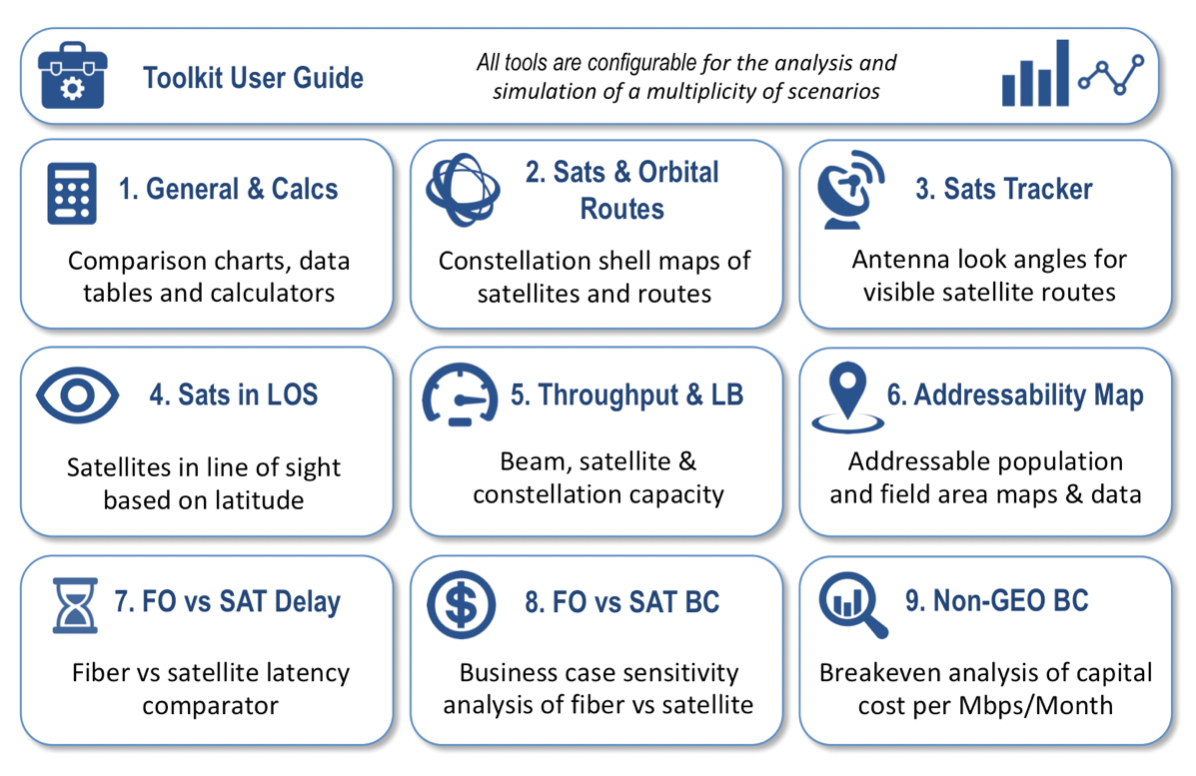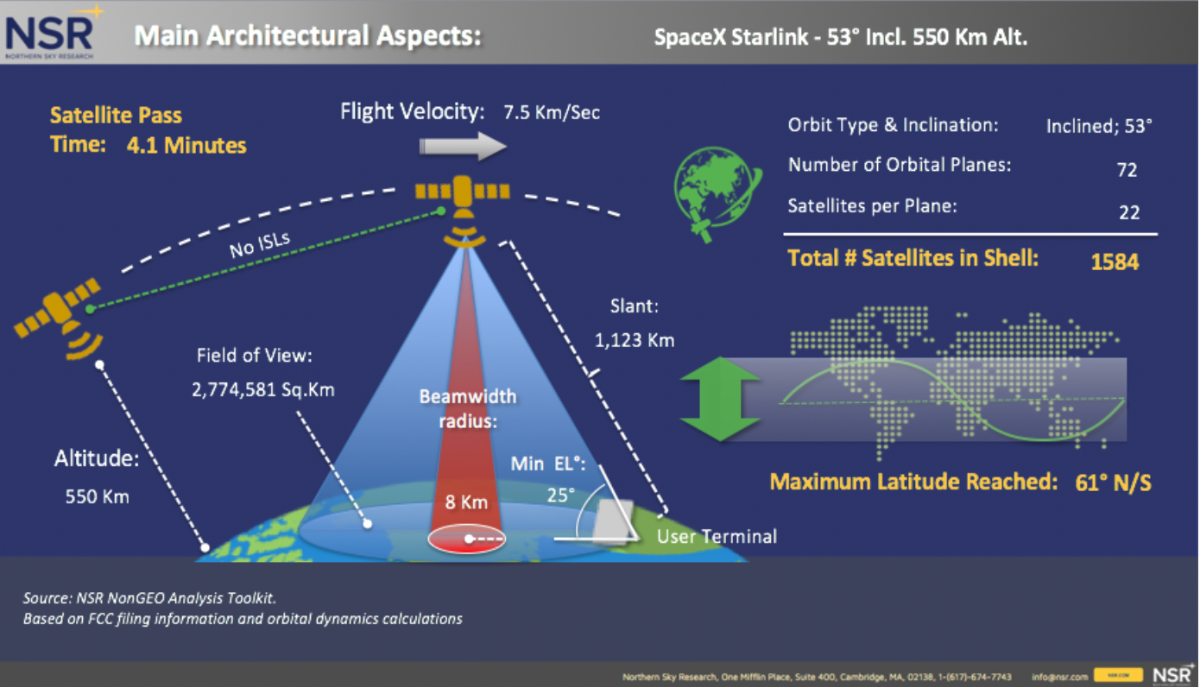Cambridge, MA – August 4, 2020
NSR’s Non-GEO Constellations Analysis Toolkit, released today, provides clients with an unbiased analytical framework to conduct internal assessments of LEO and MEO high-throughput satcom. With pre-loaded datasets and logic driven by configurable filters and inputs, the toolkit delivers an output-rich set of technical and business metrics benchmarking HTS constellations’ capabilities and performance.
Mega-constellations comprising thousands of HTS satellites beaming globally tens of Terabits per second are poised to transform the space industry, making it imperative for planners and decision makers across all telecom value chains to quantify and visualize impacts at granularly defined levels. Through a multiplicity of configurable tools, NSR’s Non-GEO Analysis toolkit puts in the hands of clients the same set of analytical instruments that NSR leverages internally to holistically assess LEO and MEO HTS in support of market research studies and targeted consulting projects.
NSR President Christopher Baugh commented on the toolkit: “This new NSR product showcases NSR’s leadership in empowering clients and supporting their evolving needs in a world that seeks 5G convergence across wireless, terrestrial and satellite network architectures. Indeed, under certain conditions LEO services can beat fiber optics, both in terms of latency and business value, making the NSR Non-GEO toolkit a useful evaluation resource for players across the wider telecommunications ecosystem.”
Comparison charts, maps, infographics, business-case simulations and other output items allow clients to conduct their own data-focused analysis, leaving out subjective, qualitative factors. “The analytical mindset for Non-GEO systems differs from GEO’s as service capabilities and economics cannot be decoupled from architectural considerations,” states Carlos Placido, NSR Senior Analyst and toolkit lead developer. “Insight into how these systems are designed and what they are factually capable of is required because characteristics such as spectrum reuse, orbital dynamics and spacecraft lifetime drive throughput, addressability and, ultimately, business viability itself.“
For the last 20 years, NSR has become a trusted component of future-looking perspectives on the satellite & space markets. NSR’s annual research and custom consulting continues to provide in-depth analysis of the industry, bottom-line perspectives, and impartial perspectives to the industry. Today, NSR’s Non-GEO Constellations Analysis Toolkit provides clients with a new, flexible resource for in-depth analysis.
Systems Analyzed in this Product
27 distinct constellation shells are analyzed for the below-listed LEO and MEO systems, including FCC-granted, in-orbit and operating, proposed systems and modifications: Amazon Project Kuiper (LEO), OneWeb (LEO), SES O3B (MEO), SpaceX Starlink (LEO), SpaceX VLEO, Telesat LEO, Telesat VLEO, ViaSat MEO and ViaSat LEO.
Now Available
NSR's Non-GEO Constellations
Analysis Toolkit
|
|
| NSR's new Non-GEO Constellations Analysis Toolkit (NCAT) puts the same set of analytical instruments that NSR leverages internally to holistically assess LEO/MEO HTS constellations in support of focused research studies and consulting projects at your fingertips. |
|
|
| NSR's Non-GEO Constellations Analysis Toolkit (NCAT) provides both business and technical professionals an in-depth understanding of Non-GEO high-throughput SATCOM. |
|
|
NSR’s Non-GEO Constellations Analysis Toolkit (NCAT) is an assembly of flexible, configurable and easy-to-use quantitative models that x-ray and benchmark leading LEO/MEO high-throughput initiatives at architectural and business layers.
The Non-GEO Constellations Analysis Toolkit (NCAT) provides a data-driven, unbiased vehicle for deep-diving into the inexorably intertwined technical and business aspects driving bandwidth supply, geographic reach, addressability and feasibility of leading mega-constellations, and their competitive standing versus terrestrial networks.
|
|
|
| The Non-GEO Constellations Analysis Toolkit (NCAT) is a standalone NSR product that may also be used in combination with market data and insight extracted from relevant NSR research studies. |
|
NSR’s Non-GEO Constellations Analysis Toolkit answers key questions:
- What are the technical differences among the leading Non-GEO-HTS initiatives?
- What is the forward and return link capacity (spectrum, bandwidth and throughput) per gateway/user beam, satellite and constellation?
- How can breakeven capital cost per usable Mbps/Month be inferred for each constellation shell? What is the sensitivity to key cost and performance elements?
- What is the maximum latitude reached by each constellation shell and how many satellites are visible based on terminal location?
- Under what conditions can mega-constellations become a more competitive option than fiber-optics to reach unserved communities? How sensitive is the business case?
- How do fiber costs and latency compare with LEO architectures, with and without Inter-Satellite Links and ground relay stations?
- What are satellite “pass time” and handoffs per hour, per system?
- How distributed are antenna “look angles” pointing at visible satellites based on terminal location?
- What is the regulatory status of each major initiative and proposed modifications?
|
|
Bottom Line: Clients can easily conduct their own assessment of Non-GEO Constellations supported by NSR-developed tools.
|
|









